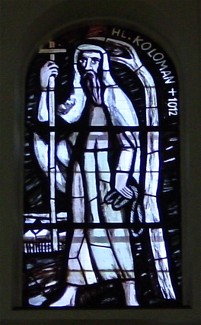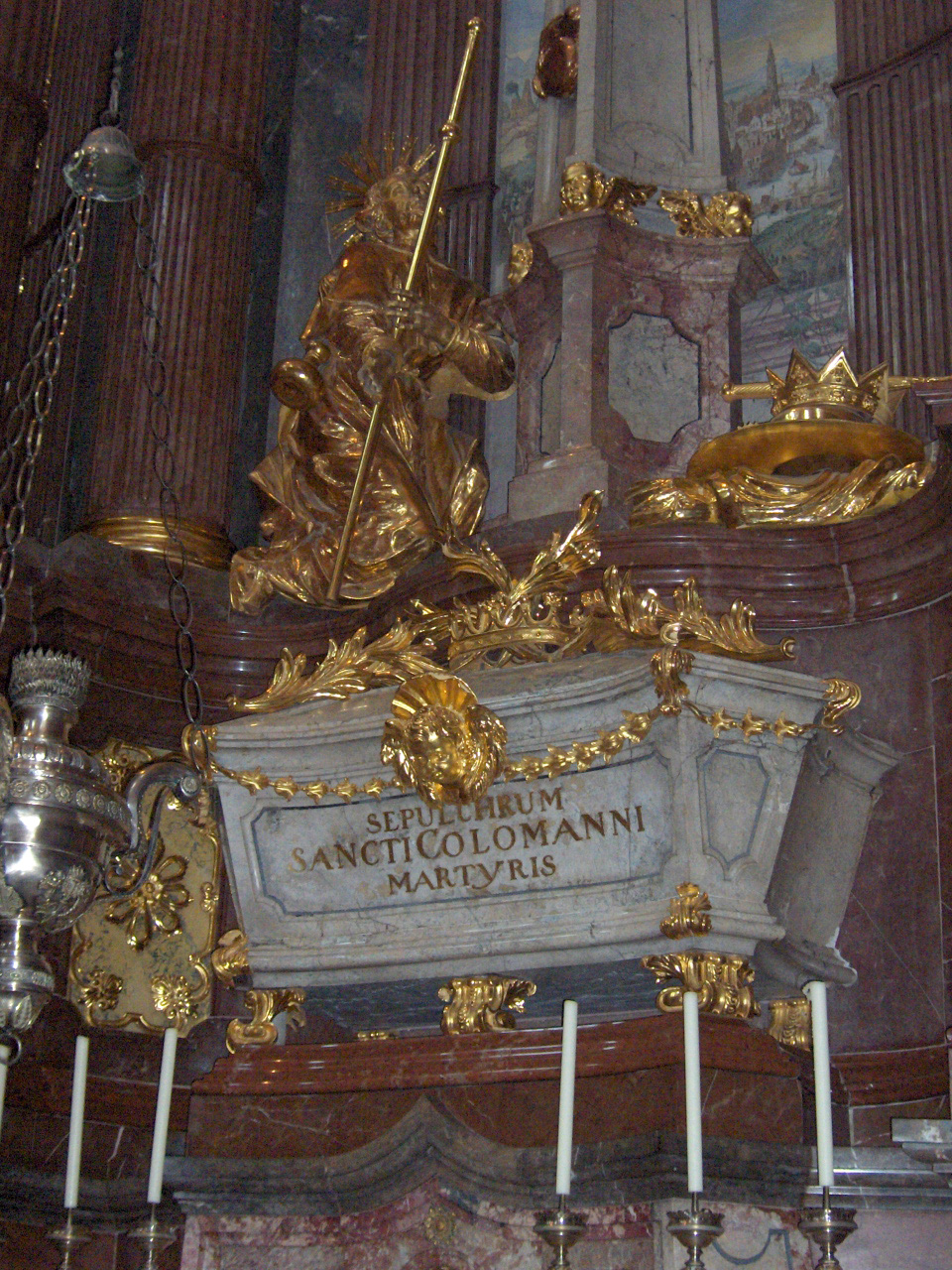Saint Coloman de Stockerau
Moine irlandais martyr
Fête le 13 octobre
† Stockerau, près de Vienne, Autriche, 18 octobre 1012
Autres graphies : Coloman, Colomannus ou Colman de Stockerau, de Melk
Moine irlandais, il se rendait en pèlerinage à Jérusalem lorsqu’il fut
arrêté et pendu à Vienne comme espion. Vénéré bientôt comme un saint, Coloman
fut adopté comme patron par la Basse-Autriche. Sous l’autel de saint Coloman,
dans l’église abbatiale de Melk (Basse-Autriche), sarcophage abritant la
dépouille du saint.
Sarcophage de Saint Colman à l'abbaye de Melk (Autriche)
Saint Colman
martyr
en Autriche (✝ 1012)
ou Coloman.
Moine irlandais qui s'en vint en Autriche pour se rendre en Terre Sainte. Les habitants le prirent pour un espion et il eut à souffrir toutes sortes de supplices avant d'être pendu à un arbre. Son corps y resta indemne pendant un an et l'arbre se mit à reverdir. A partir de ce moment, on reconnut son innocence. Son corps est désormais à l'abbaye de Melk où il est vénéré comme martyr.
(Fêté aussi le 13 octobre en certains lieux.)
Près de Stukerau, dans la région de Vienne en Bavière, l’an 1012, saint Colman. D’origine irlandaise, il se fit pèlerin pour le Christ et se mit en route vers la Terre sainte, mais, pris pour un espion ennemi, il fut pendu à un arbre et parvint ainsi à la Jérusalem du ciel.
Martyrologe
romain
Coloman of Stockerau (of Melk) M (RM)
(also known as Colman, Colomannus)
Died in Stockerau, Austria, on October 18, 1012. Saint Coloman, an Irish or
Scottish monk of royal lineage who began a penitential pilgrimage to Jerusalem
and was stopped at Stockerau, about six miles from Vienna. At that time there
were continual skirmishes between Austria, Moravia, and Bohemia. So the
stranger, who spoke no German, was accused of being a spy and, after various
tortures, hanged to death with several robbers.
For 18 months
Coloman's body remained on the gibbet, uncorrupted and unmolested by the birds
and beasts--a miracle. The scaffolding itself was said to have taken root and
sent forth green branches, one of which is preserved under the high altar of
the Franciscan church at Stockerau. Many miracles were wrought by his
incorrupt body.
Three years after
Coloman's death, Bishop Megingard translated his relics to Melk (then called
Mark, the capital of the ancient Marcomans near Moravia), at the request of
Marquis Saint Henry of Austria, who built a tomb for him in the imposing abbey
on the Danube River in western Austria. Four popes have granted indulgences to those
who pray at the shrine of Saint Coloman (or Colman?) at Melk (Paschal II,
Clement VI, Innocent VI, and Leo X). Melk burned a 70-pound wax candle in 1713
in petition for the saint's prayers against the plague that was devastating the
land.
Many churches and
chapels in Austria, Swabia, the Palatinate, Hungary, and Bavaria bear his name.
On his feast day in Melk, hundreds of horses and cattle are brought to the
abbey for Coloman's blessing. Dozens of neighboring parishes made a pilgrimage
to his chapel near Würtemberg on Whitsunday until the 18th century
(Benedictines, D'Arcy, Encyclopedia, Fitzpatrick, Gougaud, Husenbeth, Kenney,
Tommasini).
In art, Saint Colman
is a pilgrim monk with a rope in his hand. At times he may be shown (1) hanged
on a gibbet; (2) with tongs and rod; and (3) as a priest with a book and
maniple. He is venerated in Melk and Ireland. Colman is the patron of hanged
men and horses. He is invoked against plague (Roeder) and for husbands by
marriageable girls (D'Arcy).
SOURCE : http://www.saintpatrickdc.org/ss/1013.shtml
Saint Colman of Stockerau
St. Colman
Saint Colman, one of the patrons of Austria, was also an Irish
saint, who, journeying to Jerusalem,
was martyred near Vienna, in 1012, 13 October, on which day his feast is observed. His life, written by Erchenfrid
of Melk, is in "Acta SS.", VI, 357 and "Mon. Germ. Hist.:
Script.", IV, 647.
ADAMNAN, Life of St. Columba; O'LAVERTY, Down and Connor,
V; Calendar of Donegal; COLGAN, Acta Sanct. Hib.: O'HANLON, Lives
of the Irish Saints, IX; BUTLER, Lives of the Saints; HOGAN, St.
Colman of Austria; URWALEX. Der königliche Pilgen St. Colomann (Vienna, 1880).
Grattan-Flood, William. "St. Colman." The Catholic
Encyclopedia. Vol. 4. New York: Robert Appleton Company, 1908. 13 Oct. 2016
<http://www.newadvent.org/cathen/04115g.htm>.
Transcription. This
article was transcribed for New Advent by Douglas J. Potter. Dedicated to the
Immaculate Heart of the Blessed Virgin Mary.
Ecclesiastical approbation. Nihil Obstat. Remy Lafort, Censor. Imprimatur. +John M.
Farley, Archbishop of New York.
Saint Colman of Stockerau
Also known as
- Colman of Melk
- Coloman of….
- Colomannus of….
- Koloman of….
- Kálmán of….
- 13 October
- 17 July on some calendars
- 13 July on some calendars
- 18 October on some calendars
Profile
May have been of
noble or royal birth. Monk. While on a pilgrimage to the Holy Lands, Colman was stopped by the Viennese on suspicion of being a Moravian spy; there was continual fighting between Austria, Moravia and Bohemia, and a stranger who spoke no German was immediately suspect. With no evidence other than being a
stranger, he was convicted of espionage, tortured, and hanged with two thieves.
In the tradition of
the time, the bodies were left to rot as a warning to others. Colman’s body
hung there for 18 months, incorrupt, and untouched by animals. Miracles
were reported at the site, including the scaffolding taking root and putting
out branches. In 1015, bishop Megingard transferred Colman’s relics
to Melk, Austria where they were entombed in an abbey
on the Danube. The tomb became a site of miracles,
and four popes have granted indulgences to those who call on his
intercession. There is an annual blessing
of horses and cattle held at Melk and near Füssen, Germany on his feast.
Born
- in the British Isles, exact location undetermined
- against gout
- against hanging
- against plague
- hanged men
- horned cattle
- horses
- —
- Austria
- —
- Melk, Austria
- monk hanged on a gibbet
- monk with tongs
and rod
- pilgrim monk carrying a rope
- priest with a book
and maniple
October 13
St. Colman of Ireland, Martyr
IN the beginning of the eleventh century, the
neighbouring nations of Austria, Moravia, and Bohemia were engaged against each
other in implacable dissensions and wars. Colman, a Scot or Irishman, and
according to Cuspinian and other Austrian historians, of blood royal, going on
a penitential pilgrimage to Jerusalem, arrived by the Danube from the enemy’s
country at Stockheraw, a town six miles above Vienna. The inhabitants
persuading themselves that he was a spy, unjustly tortured him various ways,
and at length hanged him on a gibbet, on the 13th of October, in 1012. The
double testimony of heroic actions of virtue and of miracles is required before
any one is enrolled by the church among the saints, as Gregory IX. declares in
his bull of the canonization of St. Antony of Padua. Neither miracles suffice,
without clear proof of heroic sanctity, nor the latter without the former, says
that pope; and the same is proved by the late Benedict XIV. 1 A fervent spirit of compunction and charity, and invincible meekness
and patience under exquisite torments and unjust sufferings were an undoubted
proof of the sanctity of the servant of God, which was confirmed by the
incorruption of his body, and innumerable miracles. Three years after his death
his body was translated by the Bishop of Megingard, at the request of Henry,
marquis of Austria, and deposited at Mark, the capital of the ancient
Marcomans, near Moravia. St. Colman is honoured in Austria among the tutelar
saints of that country, and many churches in that part of Germany bear his
name. See his life written soon after his death by Crekenfred, abbot of Mark,
published by Canisius; also Dithmar in Chron. and Leopold VI., marquis of
Austria, in Chronico de Austriæ dynastis; Aventinus; Raderus, t. 3, p. 109, and
Colgan, Act. SS. Hib. p. 107, n. 12.
Rev. Alban Butler (1711–73). Volume X:
October. The Lives of the Saints. 1866

